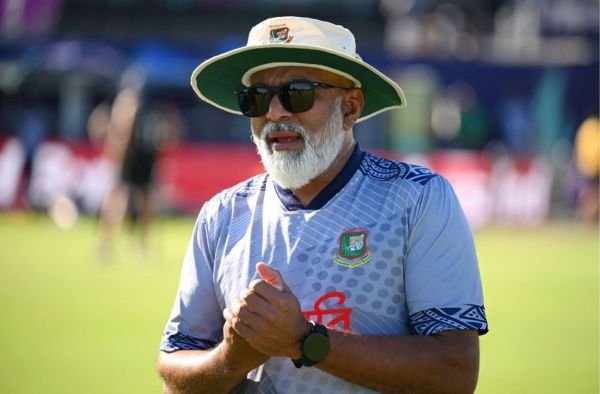If you think cricket is just about runs, wickets, and cheering fans, think again. For some, it’s also about surviving chaos off the pitch. Bangladesh head coach Chandika Hathurusingha recently shared a chilling account of how things turned frightening during a political crisis back home—and how he had to flee for his life.

In this blog post, we’ll break down what really happened, why it matters, and what it reveals about the challenges of coaching at the international level—especially in a nation dealing with instability.
Who Is Chandika Hathurusingha?
Before we dive into the story, let’s take a quick look at who Chandika Hathurusingha is. He’s a seasoned cricket coach, originally from Sri Lanka, who has twice taken up the tough job of coaching the Bangladesh national team. Highly respected in cricketing circles, Hathurusingha is known for his passion, discipline, and no-nonsense approach on and off the field.
A Coach With a Mission
When he returned to coach Bangladesh for the second time in early 2023, expectations were sky-high. The team had shown promise in recent years, and fans were excited to see what Hathurusingha could do this time around. But things didn’t exactly go as planned—especially off the field.
Trapped in Turmoil: What Exactly Happened?
During a recent interview, Hathurusingha revealed shocking details about a terrifying moment during a political crisis in Bangladesh. At one point, he genuinely thought he might not make it out alive.
So what led to this? Let’s break it down:
- Political unrest: A surge in political tensions led to unrest and protests across the country.
- Mass disruptions: Roads were blocked, cities were shut down, and violence broke out in some places.
- Safety concerns: Foreign nationals, including Hathurusingha, were advised to evacuate for their own safety.
“We Had to Leave in an Armored Vehicle”
In his own words, Hathurusingha recalled how he had to be rushed away in an armored vehicle. He and his staff drove through city streets in fear, windows up, hearts racing.
“It wasn’t just about cricket anymore,” he admitted. “I feared for my life.”
Suddenly, match strategies and team combinations seemed meaningless. The only goal now? Get out safely.
The Human Side of Coaching
We often think of international coaches as larger-than-life figures, jet-setting around the world and leading elite athletes. And while that’s part of the job, the reality can sometimes be much darker.
Like anyone else, coaches have families, fears, and personal limits. When chaos strikes, they’re not immune.
Would You Risk Your Life for Your Job?
Ask yourself: Would you be willing to stay in a dangerous situation if it meant risking your life? For many of us, the answer is likely “no.” But for coaches like Hathurusingha, the pressure to stay and deliver results—despite the risks—is enormous.
Cricket Amid Crisis: What This Means for Bangladesh
Bangladesh cricket has come a long way, becoming a competitive force in both ODIs and T20Is. But incidents like this raise important questions:
- Can international cricket truly thrive if the environment is unsafe?
- How do players and coaches handle such psychological stress?
- Should governing bodies do more to protect their teams?
These aren’t just hypothetical questions. They have a real impact on team performance, player morale, and the future of cricket in affected countries.
The Ripple Effect
When a national coach fears for his life, it sends a strong signal not just to players, but to foreign teams, sponsors, and fans. Trust and stability are key to growing any sport—and events like this chip away at both.
The Bigger Picture: Sport Isn’t in a Bubble
It’s easy to think of sports as an escape from real-world issues. But as Hathurusingha’s story shows, that’s not always the case. Politics, security, and social unrest can—and often do—spill into sports arenas, locker rooms, and training camps.
“This isn’t just about cricket,” as one journalist put it. “It’s about lives.”
Examples From Other Sports
This isn’t the first time coaches or athletes have been caught in a crisis. Remember when South Africa’s team was attacked in Lahore in 2009? Or when NFL games were postponed due to civil unrest in U.S. cities?
Sports may unite us, but they can’t always shield us from the world’s darker moments.
Moving Forward: What Can Be Done?
In situations like this, one key question arises: How do we protect sports professionals in crisis zones?
Here are a few steps that could help:
- Improved crisis protocols for athletes and coaching staff
- Stronger collaboration between sporting bodies and government authorities
- Clear evacuation plans for every international event
- Regular mental health support for all personnel
Hathurusingha’s incident is a reminder that safety should never be compromised—no matter how passionate we are about the game.
Final Thoughts: A Wake-Up Call for All
Chandika Hathurusingha’s story isn’t just an isolated incident—it’s a wake-up call. It reminds us that even the calmest matches can be played under the shadows of fear and unrest. For every six hit out of the stadium, there might be a coach wondering if he’ll make it home safely.
Cricket in Bangladesh has a bright future, no doubt. But the safety and well-being of those behind the scenes—like Hathurusingha—must never be taken for granted.